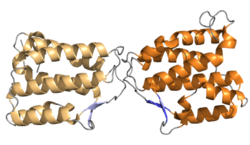
Interleukin 34

4DKC, 4DKD, 4DKE, 4DKF14643376527ENSG00000157368ENSMUSG00000031750Q6ZMJ4Q8R1R4NM_001172771NM_001172772NM_152456NM_001135100NM_029646NP_001166242NP_001166243NP_689669NP_001128572NP_083922Interleukin 34 (IL-34) is a protein belonging to a group of cytokines called interleukins. It was originally identified in humans, by large scale screening of secreted proteins; chimpanzee, murine, rat and chicken interleukin 34 orthologs have also been found. The protein is composed of 241 amino acids, 39 kilodaltons in mass, and forms homodimers. IL-34 increases growth or survival of immune cells known as monocytes; it elicits its activity by binding the Colony stimulating factor 1 receptor. Interleukin 34 (IL-34) is a protein belonging to a group of cytokines called interleukins. It was originally identified in humans, by large scale screening of secreted proteins; chimpanzee, murine, rat and chicken interleukin 34 orthologs have also been found. The protein is composed of 241 amino acids, 39 kilodaltons in mass, and forms homodimers. IL-34 increases growth or survival of immune cells known as monocytes; it elicits its activity by binding the Colony stimulating factor 1 receptor. Messenger RNA (mRNA) expression of human IL-34 is most abundant in spleen but occurs in several other tissues: thymus, liver, small intestine, colon, prostate gland, lung, heart, brain, kidney, testes, and ovary. The discovery of IL-34 protein in the red pulp of the spleen suggests involvement in growth and development of myeloid cells, consistent with its activity on monocytes. Interleukin-34 at the US National Library of Medicine Medical Subject Headings (MeSH)
